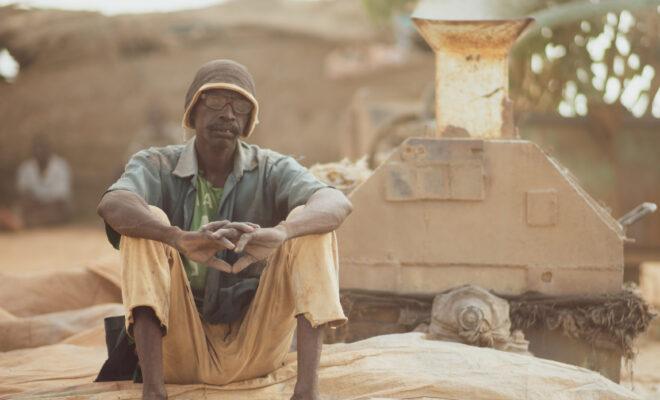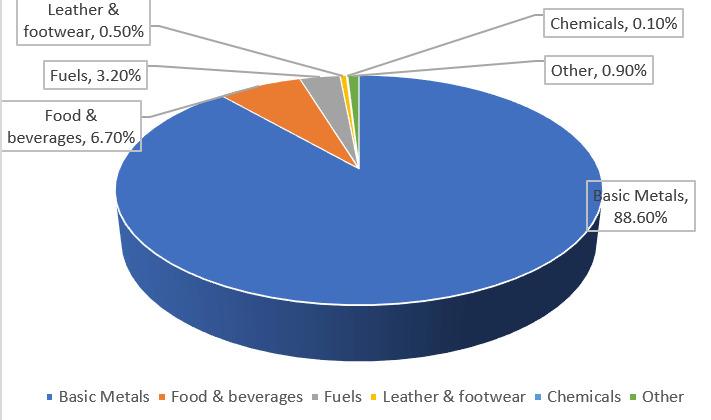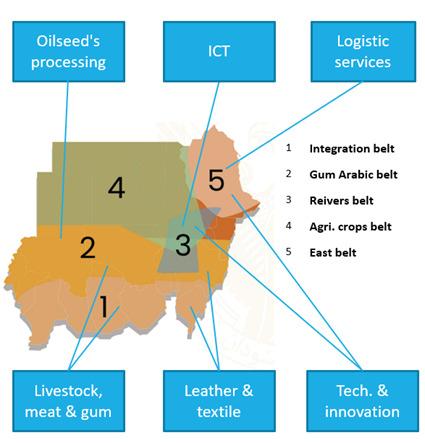
Debating Ideas is a new section that aims to reflect the values and editorial ethos of the African Arguments book series, publishing engaged, often radical, scholarship, original and activist writing from within the African continent and beyond. It will offer debates and engagements, contexts and controversies, and reviews and responses flowing from the African Arguments books.

Artisanal miners in Sudan. Credit: Ahmad Mahmoud
Industrial conditions in Sudan are simultaneously a consequence and a propagator of the country’s overall economic and development realities.[1] The country’s manufacturing exports show low levels of technology and diversification and high dependency on the basic metal extractive sub-sector. Analysis of the manufacturing sub-sectors in the country in 2016 showed that basic metals control over 88.5% of the share of exports in Sudan (Figure 1). Other manufacturing exports include low technology industries such as food and beverages, and leather and footwear. These estimations indicate that the Sudanese economy is highly dependent on mining, an industry where over 15% of the country’s population work. The majority of them (73%) having migrated from the agricultural sector.[2]
The negative environmental impacts of mining, its health impact on the labour force, as well as the involvement and control of the security apparatus over the sector,[3] render serious risks to the country’s meeting sustainable development goals and reaching political stability. The conditions in the mining sector mimic a pattern in Sudan’s modern history that was clear in the petroleum sector a decade ago.

Figure 1: Industry share of total manufacturers exports (%), 2016. Source: adapted from UNIDO 2020; see Note [1].
The need for industrial policy
Industrial policy is as old as the first industrial revolution, and since then has been active. In 1791, Alexander Hamilton, American Secretary of Treasury, submitted to the Congress his report on industry in the United States, in which he argued that the US with its industrially backward economy (which was the case back then compared to Europe) needed to protect and support its industries “in their infancy” until they reached a sufficient level of strength to compete with Europe’s manufactures. That might very well be the start of what later came to be known as infant industry support/promotion, a theory to which many – if not most – successful industrialization stories around the world are linked.[5] Nonetheless, industrial policy goes back even further to the earlier days of the British global empire, when colonial policies discouraged the advancing of manufacturing enterprises in the colonies. The empire instead preferred to keep its colonies as sources of various raw or lightly processed materials necessary for the manufacturing activities in the British Isles. The idea behind such policy was to keep the colonies dependent on the empire’s metropole in importing finished/manufactured goods, as well as to monopolize manufacturing prowess and competences; all of which to ensure the economic dominance of the metropole.
Industrial policy can be defined as any type of intervention or government measure that attempts to improve the enabling environment for industries or to alter the structure of economic activity towards sectors, technologies or tasks that are expected to offer better prospects for industrial advancement than would occur in the absence of such intervention.[6] As several industrial studies confirm, industrial policies were the main differentiating factor between the countries that achieved industrial development in the last decades (e.g. South Korea, Malaysia, Brazil, China, South Africa, Turkey) and those that did not realize any development or even showed a decline in the sector.[7] It is with this view that we treat industrial policy as critical for industrial development, and industrial development as critical for sustainable development.[8]
Sudan: from here, cautiously looking ahead
Since independence, the different governments of Sudan have issued several developmental plans that included – direct or embedded – guidelines for industrial policy. The first was the 10-year plan of 1960–70, which included increasing the performance of exports among its goals. There was also the 5-year plan of 1970–75, with import substitution as an announced goal, and many others before finally the quarter-century plan of 2003. These plans varied in their goals, their level of detailing as well as the extent of their implementation.[9]
During the years 2000–11 crude oil exports from Sudan averaged 85% of total exports. Although their share dropped dramatically to 24% in 2012 following the independence of South Sudan, a review of the sector shows that an accelerated decline in the sector’s capacity was, however, inevitable. Presentations given by ministries of the transitional government during Sudan’s National Economic Conference in September 2020 revealed a focus on investing in development wells in areas where oil was previously detected and a neglect for investment in exploration wells to define new oil reserves leading to a situation where all the oil exported from Sudan over the past 20 years has been produced from wells explored and defined in the 1970s and 1980s. Given that the country had no announced plans to reduce oil production, this path could not be justified strategically. The justification provided by the Sudanese Ministry of Energy for this low percentage of exploration work – only 23% of total wells drilled over the period 2000–19 – was the prioritization of private sector return on investment over strategic developmental goals. In addition to their high share of exports, both mining and oil production have also been a source of social instability, marked by conflicts with local communities resisting the industries’ negative environmental impact and the communities’ neglected developmental demands.[10]
These patterns of high dependence on quick-cash (or ‘niche industry’) sub-sectors and absence of strategic planning, coupled with absence of serious investment in existing resources and strategic sectors (agriculture and manufacturing), spell problems and reasons for worry. No clearer example can be presented than the very small share of leather products (0.5%) in a country with over 140 million heads of livestock. Overall, Sudan’s industrial conditions apply pressure on social and environmental sustainability, without even significant economic growth to show for it. On the other hand, much of the government’s attention on the economic front is dedicated to policies of subsidy reduction/cancellation (for fuel and electricity) accompanied by mitigating measures such as a loose universal cash aid programme (Thmarāt) supported directly by the World Bank and aimed to ‘help cushion’ the expected ‘short-term’ impact of the ‘economic reforms’ on vulnerable groups. The main argument here is that subsidy money can be redirected into long-term development projects/programmes – a general claim without an accompanied plan, yet. Nevertheless, regardless of what may be said about such policies and their implementations, less than half that effort is yet to be seen with regards to advancing the more strategic policies of industrialization and employment.
Industrial development is highly needed. However, it can only be achieved through the design and implementation of proper industrial policies. The current transitional government – that came to power in the aftermath of a popular uprising against a 30-year regime that was deemed as anti-development and power-driven[11] – is yet to issue a clear industrial policy or plan since it assumed power two years ago. Nevertheless, several governmental interventions in the forms of legislation and decisions with direct impact on the industrial sector have been issued lately by the government of Sudan. Among them are the Industry Organization & Development Act, the Investment Encouragement Act and the Public-Private Partnership (PPP) Act of 2021 (published on the official gazette, issues 1914 and 1915, May and June 2021). The Industry Organization Act was overshadowed by the latter two acts and was thus rendered toothless, since most major decisions related to industrial policy are under the scope of the PPP and Investment acts.
This regulation of industry via investment laws indicates a government orientation of legislating for economic growth rather than a holistic vision of industry as a vehicle of development. While economic growth objectives are linked to general measures that do not say much about socio-economic realities, such as high increases in annual GDP (and thus GDP per capita), industrial development reflects comprehensive socio-economic transformations through increased skilled labour employment, technological progress, and value-addition to local products. To make matters more problematic, recent acts and initiatives have their fair share of inconsistencies with sustainable development. The Industry Act, for example, met opposition from representatives of small industries and crafts due to having certification requirements only attainable to medium-to-large industries, which makes it conducive to a business environment that caters for larger industries at the expense of smaller ones. This conclusion is confirmed by the generous tax and custom exemptions provided to investors in the Investment Act in addition to deductible Corporate Social Responsibility (CSR) projects. These facilitations provided to investors – that are exclusively big investors – are not yet linked to any developmental goals or performance indicators, reflecting another failure of strategic planning. The PPP Act follows a similar approach in facilitation, in addition to having no role for state legislature in defining, approving and monitoring PPP projects. Governance of such projects is expected to be practised via a central unit that is partially financed by the projects themselves; a model that Sudan is familiar with as it was previously implemented in the Sudanese Mineral Resources Company and the Dams Execution Unit.[12] In both cases this model has left important economic sectors vulnerable to private sector capture and socio-environmental unsustainability, giving rise to conflicts with local communities fighting for their right to development.
In addition to the legislation discussed above, the transitional government of Sudan has also issued a general proposal from the prime minister’s office entitled ‘Vision, challenges & development priorities of the governance of the transitional period’. This document, issued in September 2020, included a ‘Five Development Belts’ proposal. The belts reflect a logic of focusing on existing competitive advantages of different geographical areas – including a focus on ICT in the capital and surrounding areas with existing ICT infrastructure (Figure 2). However, the proposed industrial activities within the same document in many cases do not clearly fit the belts’ definition and no follow-up guidelines or details have been issued for implementation to date. Even talk from government figures about that proposal faded away, altogether confirming that serious strategic planning is yet to materialize. The lack of a unified strategic vision undermines any chances the country has for achieving industrial and general economic development.
Stepping back a little from the plans and into reality, one finds that day-to-day sporadic initiatives rule the scene, with ministries, regulatory and implementing bodies working in silos. Strategic industrial planning is also jeopardized by the quality of data available as the last comprehensive industrial survey was conducted over 20 years ago (a new survey is planned but has yet to begin).

Figure 2: The five development belts, proposed industrial areas and activities (Source: combined from information presented in the Vision document)
Prospects
Although the current reality is rather bleak, the fight for sustainable and inclusive development in Sudan is not without allies in the industrial sector. The Industrial Research and Consultancy Center, a parastatal RTO (research and technology organization), recently restructured and launched the Institute for Industrial Policy Studies (IPS) which is the first of its kind in Sudan. According to its mandate, IPS aims to establish and enhance industrial policy in the country by providing decision-makers and stakeholders with knowledge (data, information and lessons) and recommendations needed to design evidence-based and evidence-informed policies – i.e. making industrial policy guided by evidence and by visions of sustainable/inclusive development.[13] With complex factors becoming more involved in shaping today’s economic systems, synthesized knowledge and updates become more essential for decision-making. In that light, IPS would be a key think tank that generates and synthesizes knowledge and uses it to advise, train and advocate for improving or changing policies to influence desired outcomes.[14] The engagement of IPS in the policymaking process can therefore promote sustainable development agenda if and when the political will is available.
Efforts are also underway to establish a nodal agency designed for accelerating the transformation of the agriculture and livestock sectors towards enhanced productivity as well as for the provision of increased inputs (quantity and quality) for agro-industries.[15] The initiative is learning from experiences of similar, older ones in other countries, such as Ethiopia’s Agricultural Transformation Agency. The mandate, governance and scope of the new agency will be defined by its establishing act, the draft of which is yet to be shared publicly. The efficacy of the agency will depend, among other factors, on avoiding the flaws of the PPP and Investment acts – in terms of adequate governance and control, prioritization of development over mere economic growth, etc.
It is also important to mention that these agendas are currently advanced and defended by local communities who have fought and forced their way into the policymaking process. It was the struggle of the communities in gold mining areas, for example, that led to the implementation of environmental regulations and audits on gold factories leading to the closure of some of them and the relocation of others. Communities in oil production areas have also fought for and achieved their demand for increasing the local community share of revenues. And in both sectors, local communities managed to negotiate with the government and private sector for different forms of representation in audit committees. These are clear examples of communities’ interests in sustainable and inclusive economic development. As the dialogue about industrial policy in Sudan broadens, we expect to see it being promoted and shaped by a wider range of stakeholders in industry, society, labour, and research.
If Sudan is to have any chance at sustainable development possibilities, policymakers must take industrial policy seriously. Policy agenda such as infant industry promotion, increasing local content in manufacturing, increasing the technological and innovative capacities of the labour force, and state-leadership of industrial flagship projects are a few but important trajectories that have been tried and verified in almost every successful development story in the last few decades. We’ll do well to learn from the lessons of others and build our own evidence-informed policy frameworks.
References
[1] UNIDO. 2020. Country and industry profile for Sudan [Arabic]: https://ircc.gov.sd/archives/838
[2] M. Salah Abdul Rahman. 2018. Gold Fever: the social and environmental price of gold mining [Arabic]. Cairo: Jazirat al-Ward.
[3] Jean-Pabtiste Gallopin. 2020. Bad Company: how dark money threatens Sudan’s transition. Policy Brief: European Council on Foreign Relations, June.
[4] Gussai Sheikheldin. 2018. Liberation and Technology: development possibilities in pursuing technological autonomy. Dar es Salaam: Mkuki na Nyota Publishers.
[5] United Nations Economic Commission for Africa (ECA). 2016. Transformative Industrial Policy for Africa. Addis Ababa: ECA.
[6] Warwick K, Beyond Industrial Policy: emerging issues and new trends. OECD Science, Technology and Industry Policy Paper No. 2.
[7] Carol Newman et al. 2016. ‘The Pursuit of Industry’, in Carol Newman, John Page, John Rand, Abebe Shimeles, Måns Söderbom and Finn Tarp (eds) Manufacturing Transformation: comparative studies of industrial development in Africa and emerging Asia. Oxford University Press. pp. 1–24.
[8] Arkebe Oqubay. 2016. Made in Africa: industrial policy in Ethiopia. Oxford: Oxford University Press.
[9] Atta El-Battahani (ed.). 2006. Post-war Sudanese Economy: market economics and alternative development [Arabic]. Khartoum: University of Khartoum Press.
[10] Raphaëlle Chevrillon-Guibert. 2016. ‘The gold boom in Sudan’, International Development Policy | Revue internationale de politique de développement [Online], 7 (1). DOI: https://doi.org/10.4000/poldev.2258; and M. Salah Abdul Rahman. 2018. Gold Fever, op. cit.
[11] Yagoub Elryah. 2016. ‘Analysis of the recent Sudanese industrial policy in the new structural economics framework: the way towards economic transformation’, Journal of Behavioural Economics, Finance, Entrepreneurship, Accounting and Transport, 4 (2): 35–39. https://ssrn.com/abstract=2946117
[12] The Dam Execution Unit (DIU) was established by presidential decree 217-2005, and it reported to the head of state directly. Soon it became notorious; for example, while the original budget for the Merowe dam was 1.6 billion USD, it eventually nearly doubled under the supervision of the DIU, with superficial justification. Eventually, it returned under the supervision of the Minister of Irrigation.
[13] IRCC Sudan. 2020. Institute for Industrial Policy Studies (IPS): https://ircc.gov.sd/en/institute-for-industrial-policy-studies-ips-en
[14] Bitrina Diyamett, Hezron Makundi and Gussai Sheikheldin. 2019. Science, Technology and Innovation (STI) Policy Training for Africa: basic module on reconciling theory, practice and policies. Dar es Salaam: STIPRO. Handbook prepared for the Science Granting Councils Initiative (SGCI): https://bit.ly/35cyEgC
[15] Sudan News Agency (SUNA), 7 September 2021, https://suna-news.net/read?id=722117




